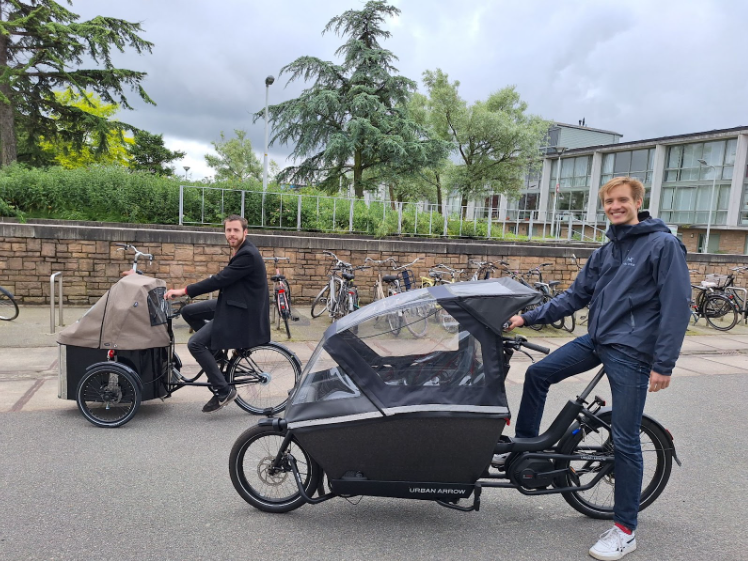It’s impossible to imagine the Dutch street scene without the cargo bike. It’s ideal for transporting goods and especially popular for shuttling children from A to B. Surprisingly, however, no real research has been done on the comfort of children during cargo bike rides. Mechanical engineering students Jelmer, Renate, Dirk-Jan, Santo and Alexander set out to change this. The final project for their bachelor’s degree is the first step in this unexplored area of research.
The students measured comfort levels by examining the effect of tyre pressure, different types of cargo bikes and road surfaces. They used a special dummy that replicates the size and weight of an average five-year-old child. They attached accelerometers to the dummy’s head and the bike’s frame and seat to record vibrations during the ride. ‘This data allowed us to analyse the accelerations,’ explains Jelmer. ‘Using a Fourier transform, we converted the vibrations into frequencies, which gave us a better understanding.’
Over the course of 20 weeks, the students covered many kilometres and carried out numerous tests to refine their measurement method. They developed a checklist to ensure that each test was carried out consistently, including specifications such as tyre pressure, the cyclist’s weight and the placement of the accelerometers. Their tests were conducted at an average speed of 18 km/h, with tyre pressures set within recommended guidelines.
(Un)comfortable?
But how does all this translate into a child’s experience? ‘We used an ISO standard for adults on public transport. As there are no comparable standards for children or (cargo) bikes, the public transport guideline was the closest we could find,’ says Jelmer. According to the comfort standards, the vibrations in a cargo bike would make the ride uncomfortable to very uncomfortable for a child.
‘But when you see children in cargo bikes, it doesn’t necessarily look like they’re uncomfortable,’ says Renate. To further test their findings, they were given permission to carry out their experiments with an actual child. ‘It was a great opportunity that also gave us valuable subjective insights,’ says Dirk-Jan.
Tips for more comfort
The result was surprising: the child experienced much less discomfort than the standards predicted. This suggests that the subjective experience of comfort riding in cargo bikes differs from public transport standards. However, the students found that the comfort of children is actually influenced by several factors. Their main recommendations for improving comfort on cargo bikes are as follows:
- Reduce tyre pressure
- A two-wheeled cargo bike is more comfortable than a three-wheeled cargo bike
- Use a shock absorber on the cargo box
- Ride on smooth roads; asphalt is better than brick, and brick is better than cobblestone
Theory and practice converge
The students were surprised themselves that no research had ever been carried out on the comfort of children on cargo bikes. ‘Cargo bikes are so commonplace that once you start looking for them, you see them everywhere. With each one I saw, I wondered how comfortable the ride actually is for the child,’ says Renate. It was mainly this familiarity, along with the freedom to design their own research and the project’s hands-on nature that drew the students to the topic. ‘I enjoyed working on a project that was both practical and theoretical,’ says Alexander. Their bachelor programme allowed them to use skills such as coding and knowledge from their courses Signal Analysis and Rigid Body Dynamics, which helped them to understand and analyse the movements in the cargo bike.
The team also encountered practical challenges. ‘In addition to the research, this project was also a logistical challenge. We worked with the Dutch Cyclists’ Union, Humanetics (the company behind the dummy) and a bike shop,’ says Santo. ‘It was exciting to see if we could manage to test the dummy in different cargo bikes. I didn’t expect it to take so much time.’
Follow-up research: babies and child seats
Although the students emphasise that more research is needed to draw definitive conclusions, their project provides a valuable starting point. Later this year, assistant professor and the students’ supervisor, Jason Moore, will initiate a similar study. He wants to investigate the vibrations experienced by babies (0-1 years old) in prams, lorries and bicycle seats. ‘Our goal is to better understand when it is safe to transport babies in these conditions,’ says Moore.
Study programme
In the Bachelor programme in Mechanical Engineering, you use knowledge of mathematics and physics to invent, design, make and improve devices and systems. To make people's lives easier, safer and more enjoyable. But also to ensure that the world becomes ever more sustainable. As a mechanical engineer, you are an indispensable link between technological developments and society!


